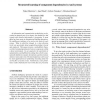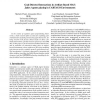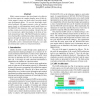104
Voted
IAT
2008
IEEE
15 years 27 days ago
2008
IEEE
Knowledge about user goals is crucial for realizing the vision of intelligent agents acting upon user intent on the web. In a departure from existing approaches, this paper propos...
91
Voted
IAT
2008
IEEE
15 years 27 days ago
2008
IEEE
Scaffolding techniques allow human instructors to support novice learners in critical early stages, and to remove that support as expertise grows. This paper describes nAble, an a...
102
Voted
IAT
2008
IEEE
15 years 27 days ago
2008
IEEE
As information and communication technologies are becoming an integral part of our homes, the demand for AmI systems with assistive functionality is increasing. A great effort has...
123
Voted
IAT
2008
IEEE
15 years 27 days ago
2008
IEEE
This paper presents iFALCON, a model of BDI (beliefdesire-intention) agents that is fully realized as a selforganizing neural network architecture. Based on multichannel network m...
97
Voted
IAT
2008
IEEE
15 years 27 days ago
2008
IEEE
This paper focuses on how capabilities to interpret another agent's emotions, and their biological realisation can be modelled. First a cognitive and a biological agent model...
91
Voted
IAT
2008
IEEE
15 years 27 days ago
2008
IEEE
To ensure multi-agent based simulation models reproducibility, particular attention must be payed on its possible implementation ambiguities. This concerns every aspect of simulat...
100
Voted
IAT
2008
IEEE
15 years 27 days ago
2008
IEEE
In the context of cognitive agent programming frameworks, a main research effort accounts for exploiting goalorientation for specifying and enacting agent interaction. Existing re...
115
Voted
IAT
2008
IEEE
15 years 27 days ago
2008
IEEE
Use of game-theoretic models to address patrolling applications has gained increasing interest in the very last years. The patrolling agent is considered playing a game against an...
102
Voted
IAT
2008
IEEE
15 years 27 days ago
2008
IEEE
TD-FALCON (Temporal Difference - Fusion Architecture for Learning, COgnition, and Navigation) is a class of self-organizing neural networks that incorporates Temporal Difference (...
118
click to vote
IAT
2008
IEEE
15 years 27 days ago
2008
IEEE
While context-awareness has been found to be effective for decision support in complex domains, most of such decision support systems are hard-coded, incurring significant develop...



